Managing waste in ancient mega cities like Rome presented formidable challenges. With populations exceeding a million inhabitants, the sheer volume of refuse and human waste demanded sophisticated solutions. Roman waste management went beyond simple disposal; it was integral to maintaining public health and urban order.
Sanitation played a crucial role in preventing disease and ensuring a livable environment for Rome’s diverse population. The city’s infrastructure had to support not only drainage and sewage but also address the social dimensions of cleanliness across different neighborhoods. In fact, maintaining cleanliness was so essential that it even extended to the religious practices of the Romans, who believed that proper sanitation was a way to please their gods. This belief system emphasized the importance of maintaining good relationships with these deities, often achieved through rituals and sacrifices that were deeply connected to their daily lives.
Key aspects of Roman waste management include:
- Innovative engineering systems such as sewers and public latrines
- Regulatory frameworks overseen by officials to maintain hygiene standards
- Early practices of recycling and resource reuse within urban settings
These elements combined to create one of antiquity’s most advanced sanitation networks, demonstrating how Romans managed waste and recycling in mega cities of antiquity with impressive efficiency. The Roman Pantheon, which includes gods associated with power, justice, and wisdom, reflects the values and beliefs that influenced every aspect of Roman life, including their approach to waste management.

The Scale and Complexity of Roman Mega Cities
At its peak, the ancient Rome population is estimated to have exceeded one million inhabitants, making it one of the largest urban centers in the ancient world. Such a dense population created immense pressure on urban infrastructure, especially waste management systems. Narrow streets, multi-story insulae (apartment buildings), and bustling marketplaces all contributed to significant amounts of refuse generated daily.
Challenges Faced by Ancient Rome
The challenges faced by ancient Rome in managing waste included:
- High population density: Crowded living quarters meant waste accumulated rapidly, requiring efficient removal methods.
- Diverse waste types: Household garbage, human waste, industrial byproducts, and organic refuse needed separate handling strategies.
- Limited space: Urban sprawl was constrained by city walls, forcing planners to optimize land use for both living and sanitation purposes.
Roman Solutions: Engineering and Planning
To manage these issues, Romans relied on advanced engineering techniques like extensive sewer networks and aqueducts delivering fresh water. Comprehensive urban planning involved:
- Designing drainage channels beneath streets.
- Strategically locating public latrines and baths.
- Coordinating waste collection services across neighborhoods.
This level of infrastructure sophistication was crucial for maintaining public health in such sprawling mega cities of antiquity. Managing waste effectively under these conditions demanded innovation not only in construction but also in governance and social organization.
Legacy of Roman Urban Planning
The impact of such sophisticated urban planning extended beyond immediate public health benefits. It laid the groundwork for future legal systems, influencing modern legal structures across the globe. Moreover, the trade and economy during this period were foundational to its vast empire, shaping daily life and long-term stability.
The artistic expression of this era is also noteworthy. Roman art emerged from the confluence of various cultures, reflecting not only the aesthetic values of its time but also the social, political, and cultural dynamics that shaped the Roman world.
Furthermore, the military strategy employed during this time was a reflection of the empire itself—vast, diverse, and intricately structured.
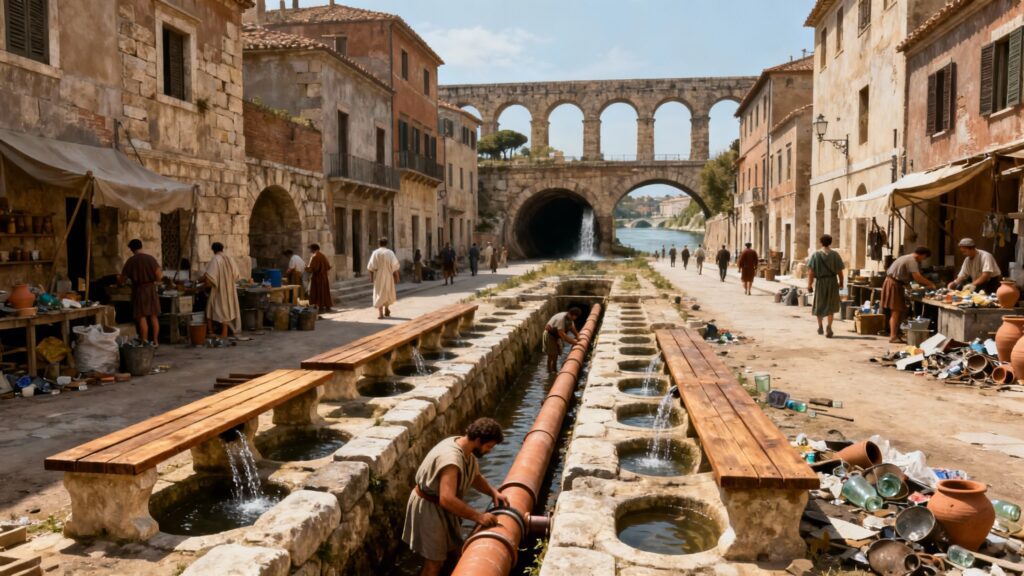
Engineering Innovations in Roman Sanitation
Roman sanitation engineering reflects a remarkable blend of innovation and practicality, addressing the immense waste management needs of a sprawling metropolis. One of the most iconic features of this system was the Cloaca Maxima, a monumental sewer originally constructed in the 6th century BC that evolved into an extensive network capable of draining both stormwater and human waste away from urban areas. This infrastructure laid the groundwork for subsequent advances in sanitation.
Public Latrines and Waste Flushing Systems
Public latrines were essential components of Roman urban life, serving as communal facilities strategically scattered throughout the city. These latrines were more than simple toilets; they were sophisticated constructions designed to support public health through effective waste removal.
Design Elements
Roman public latrines typically consisted of long stone benches with regularly spaced holes, allowing multiple users simultaneously. Water channels ran beneath these seats to carry away waste continuously.
Flushing Mechanism
A constant stream of water flushed waste away, relying on gravity and hydraulic engineering to ensure cleanliness and prevent odor buildup. This flushing water often originated from nearby aqueducts, demonstrating the interconnectedness of Rome’s water infrastructure.
Social and Hygienic Role
Latrines were social spaces but also crucial in reducing contamination risks by channeling human waste efficiently into the sewer system rather than allowing it to accumulate in streets or courtyards.
Terra Cotta Pipes Sealed with Concrete
The transportation of wastewater from homes and public facilities into larger sewers required durable, reliable piping systems. Romans employed terra cotta pipes for this purpose, which offered several advantages:
- Material Durability: Terra cotta was resistant to corrosion and easy to produce in standardized sections, making it ideal for extensive underground piping networks.
- Sealing Techniques: Joints between pipe sections were sealed using a form of hydraulic concrete or mortar, ensuring watertight connections that prevented leakage into surrounding soil and minimized infiltration by external contaminants.
- Integration with Sewers: These pipes connected individual buildings directly to main sewer conduits like the Cloaca Maxima, providing an efficient route for wastewater.
The combination of terra cotta pipes and concrete sealing allowed Rome’s sanitation system to handle significant volumes of liquid waste reliably over long distances beneath densely populated neighborhoods.
The Cloaca Maxima and Its Role
The Cloaca Maxima represented both an engineering marvel and a functional backbone for urban sanitation:
- Initially an open drainage canal designed to remove excess water from low-lying areas around the Roman Forum.
- Transformed over time into a covered sewer with vaulted stone ceilings that protected flow channels while preventing contamination of surface environments.
- Connected to various smaller sewers fed by residential drains and public latrines through terra cotta piping networks.
- Discharged wastewater into the Tiber River outside city limits, effectively removing harmful pollutants from densely inhabited zones.
The scale of this project underscores how Roman engineers prioritized not only infrastructure durability but also environmental health concerns by redirecting waste away from populated areas.
Integration with Broader Urban Planning
Engineering innovations like public latrines equipped with flushing systems and robust terra cotta pipes did not exist in isolation. They formed part of a comprehensive approach combining:
- Careful planning of street layouts that allowed installation and maintenance access to underground sewers.
- Allocation of resources such as aqueduct water specifically for sanitation purposes.
- Collaboration between engineers, architects, and city officials responsible for maintaining urban hygiene standards.
This holistic strategy ensured that sanitation infrastructure could keep pace with population growth while minimizing public health risks associated with unmanaged waste.
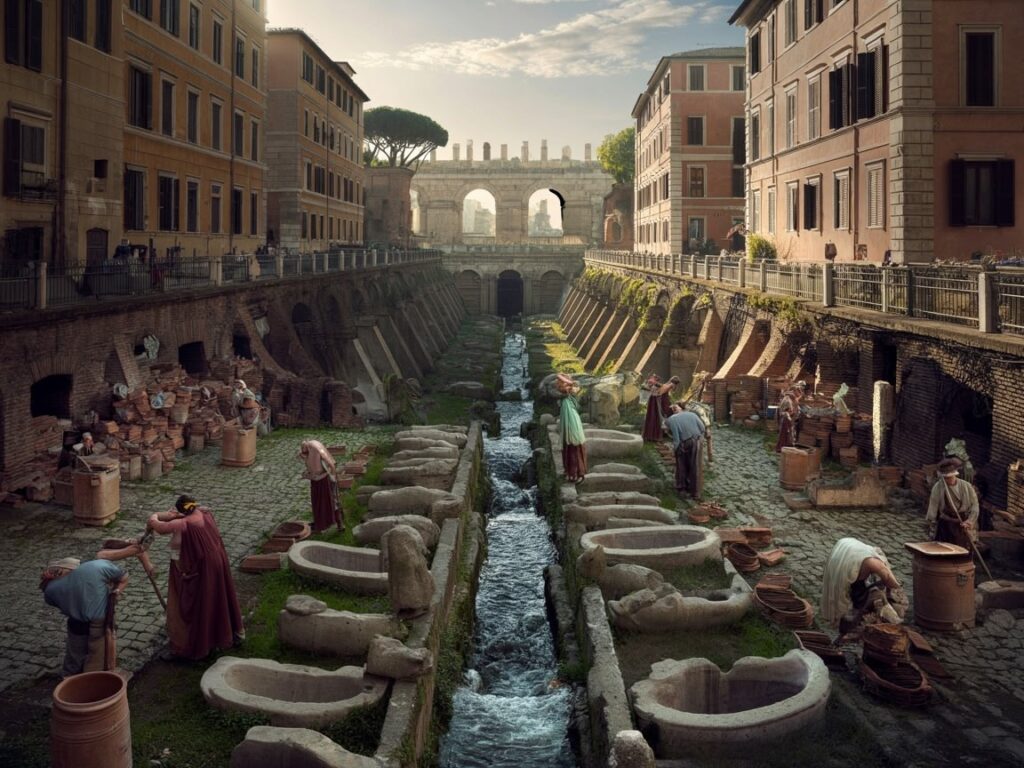
How Romans Managed Waste and Recycling in Mega Cities of Antiquity depended heavily on these engineering advancements. Public latrines channeled human waste seamlessly into vast sewer networks supported by durable materials like terra cotta pipes sealed with concrete. The Cloaca Maxima remains one of antiquity’s most impressive feats, illustrating Rome’s commitment to hygienic living conditions through advanced ancient sanitation engineering.
Aqueducts and Water Supply for Sanitation
The Roman aqueducts are impressive examples of ancient sanitation engineering, crucial for the city’s public health and cleanliness. Rome’s water system was built on eleven major aqueducts, which brought large amounts of fresh water from faraway places directly into the city. This dependable supply served several important purposes:
- Drinking water for the urban population, ensuring access to clean and safe hydration.
- Bathing facilities, which were central to Roman hygiene culture and social life.
- Flushing systems in Roman public latrines, where continuous water flow helped remove waste efficiently.
- Cleaning of streets, fountains, and other public spaces to prevent dirt and garbage buildup.
The abundance and steady flow of water allowed the Cloaca Maxima—Rome’s iconic sewer system—to work effectively. Originally an open drainage channel, it developed into a complex underground sewer network that relied heavily on water supplied by aqueducts for flushing waste away from both public buildings and private homes.
Water moved through a complex system of channels and pipes, including durable terra cotta conduits sealed with concrete, connecting plumbing fixtures directly to sewers. This ensured that wastewater was quickly carried out of the city, reducing the risk of contamination or stagnation.
The significance of a constant water supply cannot be emphasized enough: without it, even the most advanced sanitation system would fail. The aqueducts’ ability to deliver clean water on a large scale supported the entire urban sanitation effort, making Rome a leader in how Romans managed waste and recycling in mega cities of antiquity by combining hydraulic engineering with urban planning.
However, this incredible infrastructure wasn’t immune to the larger social-political issues facing the empire. The decline of the Western Roman Empire serves as a stark reminder of how political instability and weak leadership can weaken even the mightiest civilizations. As one of history’s most powerful empires, Rome’s downfall was not just caused by outside attacks but also by a complicated mix of internal conflicts and ineffective governance.
Moreover, while we often view Roman achievements through their engineering skills or military victories, it’s essential to acknowledge their rich cultural contributions too. The evolution of Roman sculpture, for example, not only shows artistic expression but also serves as tools for political propaganda and religious devotion. This art form changed significantly over time, highlighting a clear emphasis on realism and the depiction of power, reflecting ancient Rome’s societal dynamics.
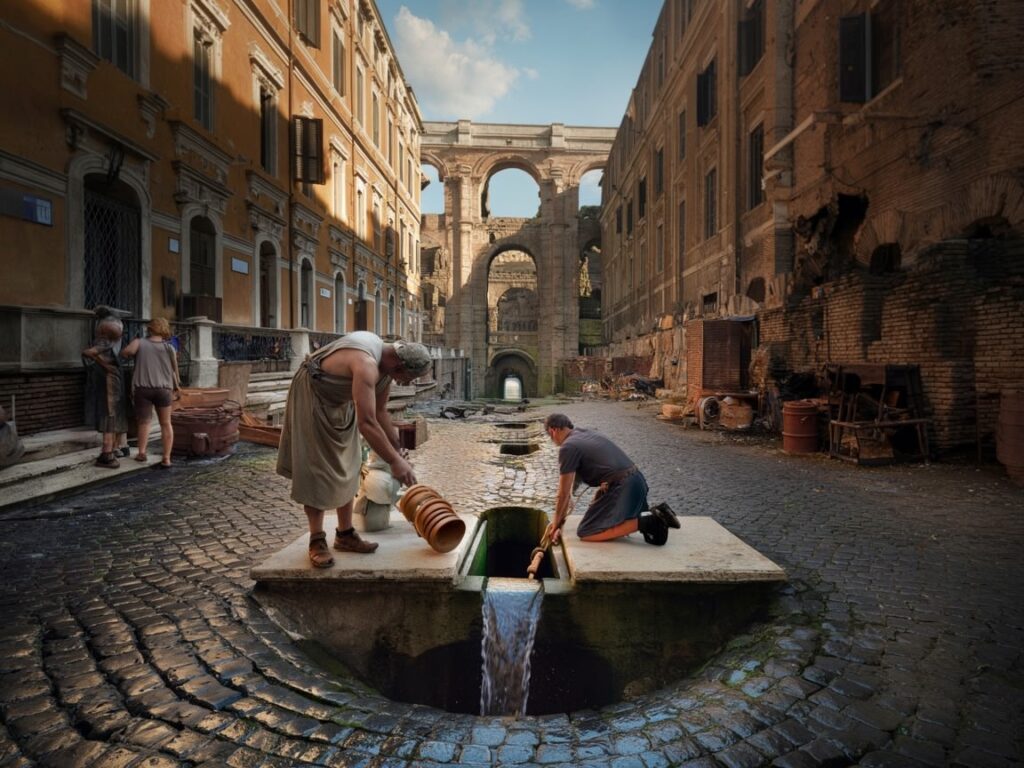
Administrative Oversight and Public Hygiene Regulation
The management of sanitation in ancient Rome relied heavily on a structured administrative system. Central to this were the Roman aediles, elected officials charged with maintaining public order and enforcing health regulations. Their responsibilities extended to:
- Monitoring the proper functioning of drainage systems to prevent blockages and flooding.
- Organizing regular street cleaning to reduce waste accumulation and maintain urban cleanliness.
- Supervising marketplaces to ensure sanitary conditions where food was sold.
- Overseeing public festivals and events with attention to hygiene standards.
These duties positioned aediles as crucial figures in sanitation oversight and public health regulation, reflecting the Roman commitment to preserving urban order through efficient governance.
The Role of Bathhouses in Roman Society
Bathhouses held immense cultural and hygienic significance in Roman society, serving as essential centers for daily cleansing rituals. The maintenance of these facilities was another key responsibility linked to public health. Bathhouses provided:
- Access to clean water for bathing, which was considered vital for physical well-being.
- Social spaces where citizens from various classes could engage in cleansing routines.
- Facilities that promoted communal hygiene practices, reducing disease transmission.
Regular upkeep of bathhouses ensured their continued operation, reinforcing the cultural emphasis on cleanliness. This institutional support for hygiene extended beyond infrastructure, embodying a societal value placed on health and sanitation.
Integration of Regulatory Frameworks with Cultural Norms
The combination of administrative oversight by aediles and the upkeep of bathhouses exemplifies how Rome integrated regulatory frameworks with cultural norms. These measures helped sustain effective waste management systems and promoted public hygiene within one of antiquity’s largest urban centers.
The influence of such administrative practices extends beyond ancient Rome, laying foundational aspects for modern society’s approach towards public health and sanitation.
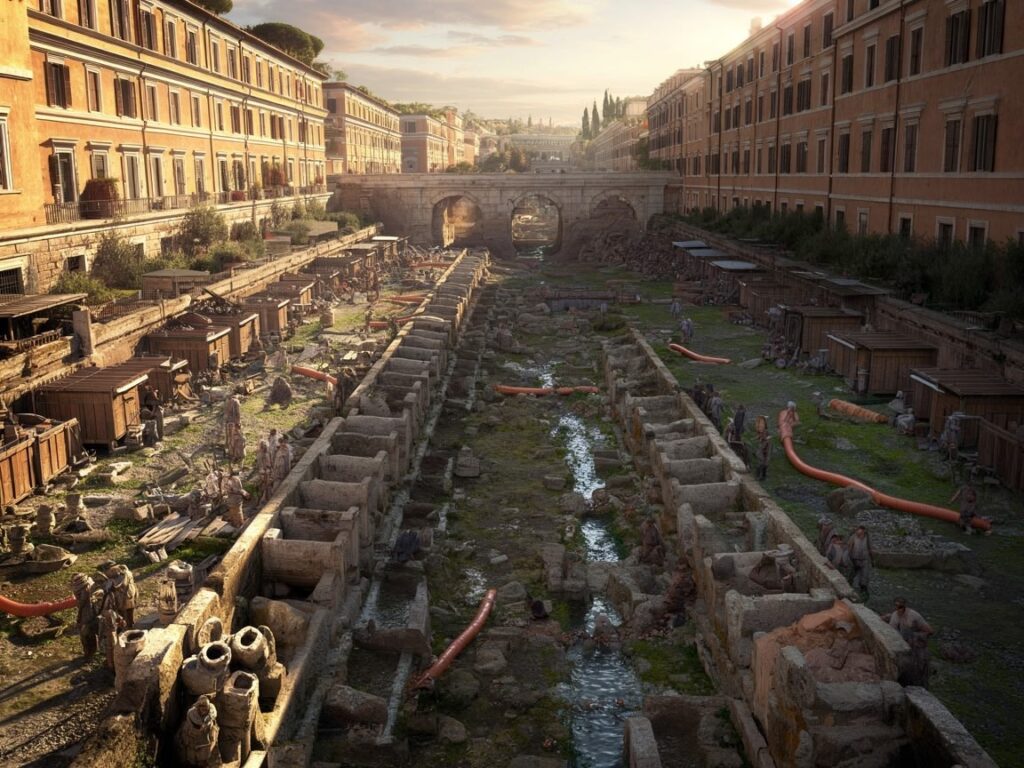
Challenges in Waste Management Across Social Strata
In ancient Rome, urban poverty created a significant gap in access to waste disposal services. Wealthier neighborhoods had the advantage of being directly connected to sewer systems and having regular street cleaning services, while poorer districts often did not have these facilities. This led to narrow alleys in marginalized areas becoming hotspots for waste accumulation, as rubbish was frequently thrown into the streets or dumped in open spaces.
Key Challenges Faced by Low-Income Areas
Several key challenges contributed to the waste management issues faced by low-income areas in ancient Rome:
- Lack of infrastructure: Many low-income homes were not connected to sewers, leaving residents to rely on basic methods like cesspits or simply throwing waste outside. The lack of proper sanitation facilities further exacerbated the situation.
- Rubbish buildup: Accumulated garbage attracted pests and created unpleasant smells, leading to uncomfortable living conditions.
- Disease spread in ancient Rome: Unsanitary environments in impoverished neighborhoods facilitated outbreaks of diseases such as dysentery and typhoid fever, which thrived where waste management was inadequate.
These disparities highlight how sanitation infrastructure was unevenly distributed, directly impacting public health outcomes. The inability to manage waste effectively in these neighborhoods increased health risks for residents and made it difficult to maintain hygiene standards throughout the city. Understanding these challenges emphasizes the complexity faced by Roman authorities in balancing urban sanitation across all social classes within their large cities.
Recycling Practices and Waste Disposal Methods
Archaeological evidence from Pompeii and other Roman sites reveals a culture of recycling in ancient Rome that went beyond simple waste disposal. Romans actively practiced material reuse, demonstrating an early form of sustainable resource management. Items such as broken pottery, metal scraps, and building materials were frequently repurposed rather than discarded.
Key insights include:
- Pompeii archaeology waste reuse: Excavations uncovered workshops where materials like glass and metal were melted down and reshaped. Fragments of ceramics found in domestic and public areas often show signs of being reused in mosaics or as construction filler.
- Everyday objects were repaired or modified instead of replaced, reducing the volume of waste generated within the city.
The urban environment was supported by well-organized services for handling refuse:
- Regular waste collection was conducted within densely populated neighborhoods, reducing the risk of rubbish accumulation in streets.
- Non-recyclable refuse was transported to designated landfill disposal ancient cities typically located outside city boundaries to prevent contamination within populated zones.
- These landfills were carefully managed to keep harmful effects away from water sources and living quarters.
Public officials ensured that refuse management followed strict guidelines to maintain urban cleanliness. This system helped minimize the environmental footprint of sprawling mega cities like Rome while supporting ongoing recycling efforts aimed at maximizing resource efficiency.
Interestingly, the significance of coins in ancient Rome extended beyond mere currency. They served as powerful tools for political messaging, with emperors using them to convey their authority and legitimacy. This aspect of Roman life is explored further in the article on Coins as Propaganda: The Currency of Power.
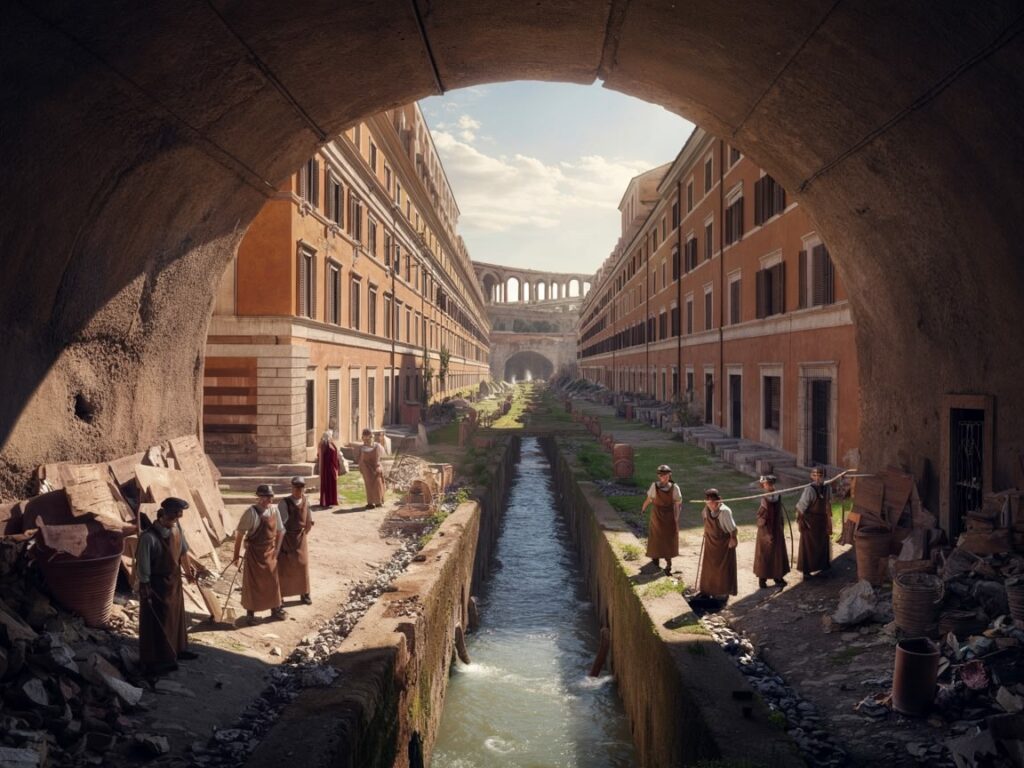
Environmental Awareness and Sustainability Measures
Roman environmental laws showed a clear commitment to regulating resources in ancient times. The authorities understood the risks of using up important natural resources and took steps to protect them for future generations.
1. Olive Tree Preservation
Olive cultivation was vital for the Roman economy and diet. Laws restricted excessive harvesting and land clearance, ensuring olive groves remained productive over long periods. This approach reflected an early form of sustainability in ancient Rome that balanced immediate needs with lasting resource availability.
2. Water Source Protection
Vital aqueducts and springs supplying drinking water to cities like Rome received special protection under municipal regulations. These policies prohibited pollution or diversion of water sources, maintaining water quality essential for public health and sanitation infrastructure.
“The Romans understood that safeguarding natural resources was crucial not just for economic prosperity but also for urban hygiene and societal welfare.”
Such regulatory frameworks reveal how How Romans Managed Waste and Recycling in Mega Cities of Antiquity extended beyond engineering innovations to encompass environmental stewardship. These efforts contributed to the resilience of Roman urban centers by preventing resource exhaustion amid expanding populations.
By combining legal control with practical sanitation systems, Rome set early examples of comprehensive urban sustainability that still resonate today.
FAQs (Frequently Asked Questions)
How did ancient Romans manage waste and sanitation in their mega cities?
Ancient Romans employed innovative engineering solutions such as the Cloaca Maxima sewer system, public latrines with flushing water streams, and terra cotta pipes sealed with concrete to effectively manage waste. They also established regulatory frameworks and administrative oversight to maintain sanitation and promote recycling practices in their sprawling urban centers.
What challenges did Roman mega cities face in waste management due to population density?
The large population size and high density in ancient Rome posed significant challenges for waste management systems. This necessitated advanced engineering techniques and comprehensive urban planning strategies to accommodate the sanitation needs of such vast urban centers, ensuring a healthy environment for all residents.
What role did Roman aqueducts play in sanitation and waste disposal?
Roman aqueducts were crucial for supplying clean water not only for drinking and bathing but also for flushing toilets and cleaning public spaces. The reliable and abundant water supply sustained the effectiveness of Roman sanitation systems, including public latrines and sewer networks like the Cloaca Maxima.
Who were responsible for overseeing public hygiene and sanitation regulations in ancient Rome?
Elected officials known as aediles were entrusted with maintaining public order, including supervising drainage systems’ proper functioning and organizing street cleaning activities. They also ensured the maintenance of bathhouses, which served as vital centers promoting hygiene practices among Roman citizens.
How did social disparities affect waste management and public health in ancient Rome?
Disparities among social classes resulted in unequal access to proper waste disposal services, leading to rubbish accumulation particularly in poorer neighborhoods. Inadequate waste management infrastructure in these marginalized areas contributed to unsanitary conditions that facilitated the spread of diseases.
What recycling practices and sustainability measures existed in ancient Roman cities?
Archaeological evidence from sites like Pompeii indicates extensive material reuse to minimize waste generation. Regular waste collection services operated within urban areas, with landfills located outside city limits for non-recyclable refuse. Additionally, environmental laws regulated resource use—such as protecting olive trees and vital water sources—to ensure long-term sustainability.

